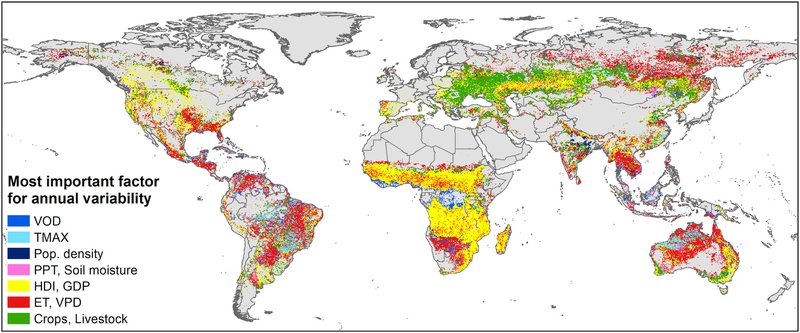23. März 2021
Human and climate drivers of global biomass burning variability
Human development a main factor driving interannual variability of burned area
Human factors influence the variability of land affected by fire in areas with medium to large burned area, according to the findings in a new paper led by Emilio Chuvieco science leader for the ESA Climate Change Initiative fire project.
The paper, published in the journal Science of the Total Environment, aimed to better understand factors explaining interannual variability in burned area (BA) at a regional and global level.
Highlights:
- Factors of global fire interannual variability were identified
- Regions with more burned area, burn also more frequently
- Human factors are more relevant in medium to large fire occurrence regions
Biomass burning is one of the most critical factors impacting vegetation and atmospheric trends, with important societal implications, particularly when extreme weather conditions occur. Around 4 million km2 are burned globally every year, about the size of India and Pakistan combined, based on recent assessments using Earth Observation satellites. This estimation is based on coarse resolution sensors, and it is likely to be conservative, as global burned area (BA) products tend to underestimation, particularly in areas with small fires.
Humans more than weather
Using statistical and machine learning approaches the authors’ explain burned area variability at global scale for an 18-year satellite record. They show that that variability of fire occurrence is more dependent on human factors in areas with medium to large burned area, particularly in tropical Africa and Central Asia, while climatic factors are more important in boreal regions, but also in the tropical regions of Australia and South America.
The new findings are consistent with the authors’ main hypothesis, that annual BA values would be more constant where fire has a stronger human control, either because they are purposely ignited for land use management or because they are intentionally extinguished.
The level of development was found to be the main factor driving interannual variability in areas with medium to large BA occurrence. BA tends to be more similar in different years when human development index values decrease, as well as when cropland and livestock density increases, probably as a result of using agricultural practices less dependent on the use of fire.

Earth observation data utilised
In addition to human related variables, satellite-derived burned area (https://climate.esa.int/en/projects/fire/) and land cover data https://climate.esa.int/en/projects/land-cover/, products from ESA’s Climate Change Initiative were used as part of the study.
Reference
Chuvieco, E. et al (2021) Human and climate drivers of global biomass burning variability. Science of the Total Environment. https://doi.org/10.1016/j.scitotenv.2021.146361

